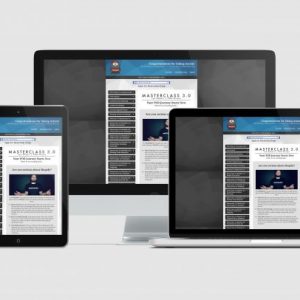No products in the cart.
Nat Eliason – Build Your Own Apps
$499.00 $33.50
- Payment method: I will send the payment link to your email.
- Deliver by: Google Drive, Mega.nz
Category: Marketing
Proof of payment:
Unlock Your Inner Coder – Nat Build with AI Power. Imagine building your own apps, even if you’ve never written a line of code. That’s the promise of a new era, fueled by AI and brought to life by innovators like Nat Eliason. The concept of nat build is rapidly evolving, empowering individuals to create custom software solutions that were once the exclusive domain of professional programmers. This paradigm shift is transforming how we interact with technology, placing the power of creation directly into the hands of everyday users.
Table of Contents
Nat build
The idea of nat build, using readily available tools and artificial intelligence to construct custom software, is a compelling vision for the future of personal and professional productivity. This approach democratizes software development, removing barriers for non-programmers and allowing them to tailor technology to their specific needs. This is more than just a passing trend; it represents a fundamental shift in how we think about and interact with the digital world.
Democratizing Software Creation
The traditional model of software development, heavily reliant on specialized coding skills, has long been a bottleneck for innovation. The promise of nat build is that it bypasses this bottleneck, allowing individuals with domain expertise – whether in marketing, operations, or even creative arts – to directly translate their ideas into functional applications. Instead of needing to explain complex requirements to a developer, users can now actively participate in the build process, leveraging AI to bridge the gap between conceptualization and execution. This reduces the potential for miscommunication, speeds up development cycles, and ultimately leads to more customized and effective software solutions. Think about the impact on small businesses, educators, or researchers who can now create tools perfectly tailored to their unique challenges, without incurring the high costs and delays associated with traditional software development.
This democratization also has implications for the future of education and workforce development. As nat build platforms become more sophisticated, the demand for traditional programmers may shift towards a need for “AI-guided developers” – individuals who possess a strong understanding of both domain expertise and the ability to effectively communicate with and guide AI-powered development tools. Education programs will need to adapt to this paradigm shift, focusing on teaching not just coding syntax, but also critical thinking, problem-solving, and the art of crafting effective prompts to guide AI in the software creation process.
The Rise of the Citizen Developer
The concept of a “citizen developer” – someone who creates applications for their own use or the use of others within their organization, without holding a formal programming background – is central to the nat build movement. These citizen developers are empowered by low-code and no-code platforms, often augmented with AI, to automate tasks, streamline workflows, and solve business problems that would otherwise require the expertise of a professional developer. The rise of the citizen developer is fueled by the increasing availability and accessibility of these powerful tools, as well as the growing recognition that business users often have the best understanding of their own needs and pain points.
One of the key benefits of citizen development is the increased agility and responsiveness it brings to organizations. Instead of waiting for IT departments to prioritize their requests, business users can take matters into their own hands, creating custom solutions that address their immediate needs. This can lead to faster innovation, improved productivity, and a greater sense of ownership among employees. However, it also raises important questions about governance, security, and maintainability. Organizations need to establish clear guidelines and best practices to ensure that citizen-developed applications are secure, reliable, and properly integrated with existing systems. They also need to provide adequate training and support to citizen developers, empowering them to create effective solutions without creating new risks.
Beyond Automation: Creative AI Application
The nat build ethos extends beyond simply automating tasks; it enables creative exploration and the development of truly unique and personalized applications. Imagine crafting a custom writing assistant that learns your style and helps you overcome writer’s block, or building a personalized fitness app that adapts to your individual needs and preferences. These are the kinds of applications that become possible when individuals are empowered to leverage AI to create tools that are perfectly tailored to their own specific goals and interests.
This creative application of AI is where the truly transformative potential of nat build lies. It’s not just about making existing processes more efficient; it’s about unlocking new possibilities and creating entirely new categories of software that were previously unimaginable. As AI models become more sophisticated and user-friendly, we can expect to see a surge in creativity and innovation, as individuals from all backgrounds begin to explore the possibilities of building their own custom AI-powered applications. The key is to provide the right tools, resources, and support to empower these creators and foster a culture of experimentation and innovation.
Plywood cut calculator
The plywood cut calculator, while seemingly unrelated to AI-powered app development, exemplifies the power of creating custom tools to solve specific problems. It demonstrates the same spirit of resourceful problem-solving that motivates the nat build movement. Just as Nat Eliason‘s course empowers individuals to create unique software solutions, a plywood cut calculator empowers woodworkers and DIYers to optimize material usage and minimize waste.
Optimizing Resources with Digital Precision
In the world of woodworking and construction, efficient material usage is crucial for both cost savings and environmental sustainability. A plywood cut calculator is a valuable tool that helps users determine the optimal way to cut plywood sheets, maximizing the number of usable pieces and minimizing waste. This is not just about saving money on materials; it’s also about reducing the environmental impact of woodworking projects by reducing the demand for new resources.
These calculators take into account the size of the plywood sheet, the dimensions of the pieces needed, and the kerf (the width of the saw blade) to generate cutting layouts that minimize waste. Some advanced calculators can even handle complex shapes and grain direction constraints. By using a plywood cut calculator, woodworkers can significantly reduce their material costs, minimize waste, and streamline their projects. This is a prime example of how even a seemingly simple tool can have a significant impact on efficiency and sustainability.
From Manual Calculation to Automated Solution
There was a time when woodworkers had to rely on manual calculations and trial-and-error to determine the optimal cutting layout for their plywood sheets. This was a time-consuming and often inaccurate process that could lead to significant material waste. The advent of the plywood cut calculator represents a significant step forward, automating the calculation process and providing users with precise cutting layouts in a matter of seconds.
These calculators are available in a variety of formats, from simple online tools to sophisticated software programs. Some are even integrated into CAD (Computer-Aided Design) software, allowing users to seamlessly incorporate cutting layouts into their project designs. By automating the calculation process, these tools free up woodworkers to focus on other aspects of their projects, such as design and craftsmanship. They also reduce the risk of human error, leading to more accurate cutting layouts and less wasted material.
Connecting the Dots: Efficiency Across Domains
While a plywood cut calculator might seem like a niche tool, it shares the same underlying principle as the AI-powered app development that Nat Eliason champions: using technology to solve specific problems and improve efficiency. Just as nat build tools empower individuals to create custom software solutions, a plywood cut calculator empowers woodworkers to optimize material usage and minimize waste. Both are examples of how technology can be used to make our lives easier, more efficient, and more sustainable.
The key takeaway is that the spirit of innovation and problem-solving transcends specific domains. Whether you’re building a custom app with AI or optimizing the cutting layout for a plywood sheet, the goal is the same: to leverage technology to achieve a desired outcome more effectively. This is the driving force behind the nat build movement and the reason why it has the potential to transform so many different areas of our lives.
Nat apps
The concept of Nat apps represents the culmination of the nat build philosophy: individuals empowered to create and deploy their own applications, tailored to their specific needs and interests. These apps are not necessarily destined for the app store; they are often personal tools designed to enhance productivity, streamline workflows, or simply make life a little easier.
The Power of Personalization
The beauty of Nat apps lies in their personalization. Unlike generic apps designed to appeal to a broad audience, Nat apps are created with a specific user in mind – the creator themselves. This allows for a level of customization and specificity that is simply not possible with off-the-shelf software. Whether it’s a custom task manager, a personalized habit tracker, or a streamlined note-taking system, Nat apps can be tailored to perfectly fit the user’s workflow and preferences.
This personalization translates into increased efficiency and productivity. When an app is designed specifically for your needs, you’re less likely to waste time navigating unnecessary features or adapting to clunky interfaces. You can focus on what matters most, knowing that your tools are working with you, not against you. This is the power of Nat apps: the ability to create tools that are perfectly aligned with your own unique needs and goals.
From Idea to Implementation
The process of creating Nat apps is often driven by a personal need or frustration. The user identifies a problem that they want to solve or a task that they want to automate, and then they set out to build an app that addresses that specific need. This process is often iterative, with the user constantly refining and improving the app based on their own experiences and feedback.
The availability of low-code and no-code platforms, coupled with the power of AI, has made it easier than ever for individuals to bring their app ideas to life. Even without formal programming skills, users can now create functional applications that solve real-world problems. The key is to embrace the nat build philosophy: focus on learning just enough programming knowledge to guide AI and overcome limitations, and prioritize practical, project-based learning.
The Future of Tailored Technology
The rise of Nat apps represents a significant shift in how we think about and interact with technology. Instead of relying on generic apps designed for the masses, we are moving towards a future where individuals are empowered to create their own custom solutions, tailored to their specific needs and preferences. This is a future where technology is truly personal and empowering, allowing us to achieve our goals more efficiently and effectively.
As AI continues to evolve and low-code/no-code platforms become more sophisticated, we can expect to see an explosion of creativity and innovation in the world of Nat apps. Individuals from all backgrounds will be empowered to build their own custom tools, transforming the way we work, learn, and live. The key is to foster a culture of experimentation and innovation, providing the resources and support that individuals need to bring their app ideas to life.
Nat Eliason
Nat Eliason is more than just an instructor; he’s a catalyst for change in the way people approach software creation. His work centers around empowering individuals, regardless of their coding background, to harness the power of AI and build custom applications that enhance their lives and careers. He stands as a beacon for the nat build movement.
The “Hacker” Mindset
Nat Eliason‘s approach to software development is characterized by a “hacker” mindset – a focus on practical problem-solving, creative experimentation, and a willingness to learn just enough to get the job done. He doesn’t advocate for becoming a traditional programmer; instead, he emphasizes the importance of understanding key programming basics and how to effectively guide AI in the software creation process.
This pragmatic approach is particularly appealing to individuals who are intimidated by the complexities of traditional programming. Nat Eliason demystifies the process, showing that anyone can learn to build custom applications with the help of AI, even without years of formal training. His emphasis on practical, project-based learning ensures that students acquire the skills they need to start building real-world applications right away.
Author, Entrepreneur, and AI Advocate
Nat Eliason‘s background as an author, entrepreneur, and experienced “software hacker” lends credibility to his teaching. He’s not just a theoretical instructor; he’s someone who has spent years building his own software solutions to streamline his work and enhance his productivity. He understands the challenges and frustrations that non-programmers face when trying to build custom applications, and he’s developed a methodology that addresses those challenges head-on.
His real-world experience and entrepreneurial spirit make him a relatable and inspiring instructor. He’s not afraid to share his own struggles and successes, providing students with valuable insights and practical advice. His passion for empowering others to leverage AI to build their own software is contagious, inspiring them to embrace the nat build philosophy and unlock their creative potential.
A Vision for the Future
Nat Eliason‘s work reflects a larger vision for the future of software development – a future where individuals are empowered to create their own custom tools, without relying on the expertise of professional programmers. He believes that AI has the potential to democratize software creation, making it accessible to anyone with an idea and a willingness to learn.
His course, Build Your Own Apps, is a testament to this vision. It provides individuals with the skills, knowledge, and confidence they need to start building their own custom applications, transforming the way they work, learn, and live. Nat Eliason is not just teaching a course; he’s building a movement – a movement that is empowering individuals to take control of their technology and create a better future for themselves and others.
Build Your Own Apps
Build Your Own Apps, the course created by Nat Eliason, is the embodiment of the nat build philosophy. It’s a comprehensive program designed to empower individuals, regardless of their coding experience, to create custom software solutions using AI. The course is structured around a practical, project-based learning approach, combining AI assistance with fundamental programming knowledge to overcome the limitations of relying solely on AI.
Overcoming the AI Limitations
One of the key differentiators of Build Your Own Apps is its emphasis on the importance of combining AI assistance with foundational programming knowledge. The course explicitly addresses the limitations of relying solely on AI for software development, warning students that they will inevitably get stuck and quit if they try to 100% rely on AI to do everything.
Instead, the course advocates for learning just enough programming knowledge to guide AI, work through problems, and break down ideas into manageable pieces that the AI can build. This approach empowers students to overcome the inevitable limitations of AI and create truly custom and effective applications. It’s not about becoming a traditional programmer; it’s about acquiring the necessary skills to effectively leverage AI for software development.
Practical, Project-Based Learning
Build Your Own Apps is designed around the idea that students learn best by building cool stuff they’re excited about. The course structure involves building progressively more complex applications, starting with a basic app running in the browser in the second video. Examples of skills learned include whipping up a web or mobile app, connecting to a database, using APIs, and so much more.
This practical, project-based learning approach ensures that students acquire not just knowledge, but also the ability to implement their knowledge and create real-world applications. As they progress through the course, they develop a portfolio of projects that demonstrate their skills and capabilities. They also gain the confidence to tackle new challenges and build even more complex applications in the future.
Community and Support
Build Your Own Apps is more than just a course; it’s a community. Students have access to a private community of other AI builders, where they can ask questions, share ideas, and collaborate on projects. This community provides a valuable source of support and encouragement, helping students to overcome challenges and stay motivated. The inclusion of weekly sessions from the instructor allows for live question answering; direct access to the instructor.
Nat Eliason also provides direct access to himself through weekly sessions, where he answers student questions and provides guidance. This personalized support is invaluable, helping students to overcome obstacles and accelerate their learning. The combination of practical training, project-based learning, and community support makes Build Your Own Apps a truly transformative experience for individuals who want to unlock the power of AI and build their own custom software solutions.
Conclusion
Build Your Own Apps, pioneered by Nat Eliason, is spearheading a new era of software development, one where individuals, empowered by AI and guided by fundamental programming concepts, can create custom applications tailored to their unique needs. This nat build movement is about democratizing technology, fostering innovation, and ultimately, empowering individuals to take control of their digital lives. From the seemingly simple, yet crucial plywood cut calculator showcasing resource optimization, to personalized Nat apps transforming productivity, the possibilities are limitless. The vision of Nat Eliason, a driving force behind making technology accessible to everyone is clear: Empowering individuals to shape their own digital world is the future!
Sales Page: _https://www.buildyourownapps.com/
Be the first to review “Nat Eliason – Build Your Own Apps” Cancel reply
Related products
$39.00
$39.00
$20.99
Sale!
Marketing
$25.00













Reviews
There are no reviews yet.